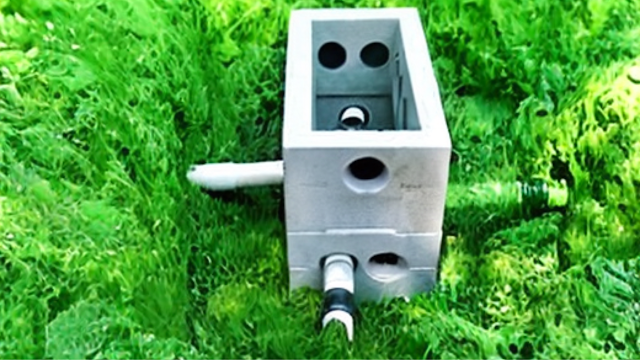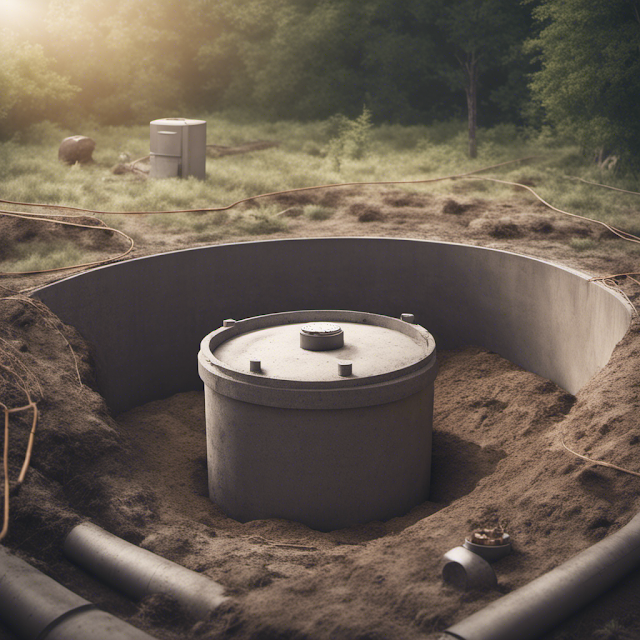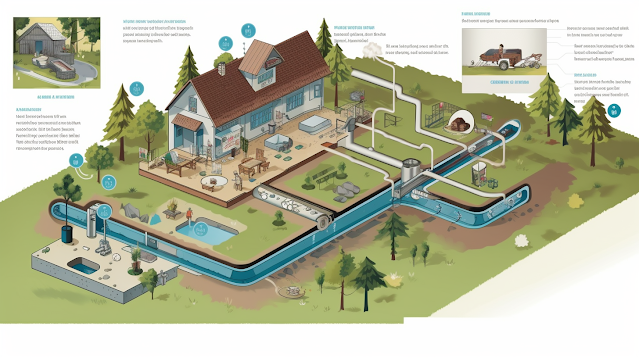Protecting Water Sources From Septic System Impacts
 |
| Preventing Contamination of Streams and Lakes |
In the battle to safeguard water sources from the detrimental effects of septic systems, homeowners must rise to the occasion. With a focus on proper design, installation, and maintenance, the onus lies on individuals to prevent the contamination of drinking water wells. By mastering the operation and upkeep of their septic systems, homeowners can shield nearby wells and implement water protection practices.
Septic systems, if not functioning optimally, can pollute streams, lakes, and other water bodies, compromising their quality. It is imperative to address failing or older systems that discharge untreated wastewater, as they pose health hazards and require water filtration and disinfection.
This article will delve into the importance of properly designed septic systems, ways to locate them away from water sources, and strategies for managing septic systems for public health. Additionally, it will explore the risks of failing or older septic systems, including contamination of groundwater and surface waters, the health risks posed by pathogens and harmful substances, and the necessary steps for remediation and treatment of contaminated water supplies.
Key Takeaways
- Properly designed, installed, and maintained septic systems are crucial in preventing contamination of drinking water wells and nearby water sources.
- Homeowners should learn how to operate and maintain their septic systems to protect the quality of nearby wells and surface water.
- Failing or older septic systems that discharge untreated wastewater can have negative impacts on water quality, including the contamination of pathogens, chemicals, and nutrients.
- Exposure to untreated wastewater from failing septic systems can pose direct health hazards to humans and pets, necessitating the need for filtration and disinfection of drinking water sources.
Importance of Properly Designed Septic Systems
Properly designed septic systems are essential for preventing contamination of drinking water wells and surface water sources. The importance of regular maintenance cannot be overstated in ensuring the functionality and effectiveness of these systems.
Septic system failures can have a significant impact on water sources, leading to contamination and potential health hazards. Failing or older septic systems that discharge untreated wastewater can introduce pathogens, chemicals, and nutrients into groundwater and surface waters. These contaminants can pose risks to both human and pet health, causing illnesses and requiring special treatment of drinking water supplies.
Additionally, septic system failures can contribute to excess nitrogen and phosphorus levels in water bodies, leading to the formation of harmful algae blooms and dead zones. Regular maintenance of septic systems is crucial in preventing these issues and protecting water sources from contamination.
Locating Septic Systems Away From Water Sources
To avoid contamination, homeowners should ensure that septic systems are installed a safe distance away from nearby water sources.
Designing septic systems safely is crucial in preventing septic system contamination and protecting water sources. When septic systems are located too close to water sources, there is a higher risk of pathogens, chemicals, and nutrients from the septic system leaching into the water, which can have negative impacts on water quality and public health.
By implementing proper design practices, such as determining appropriate setback distances and considering the soil conditions and topography, homeowners can minimize the potential for contamination.
Regular maintenance and monitoring of septic systems also play a vital role in preventing system failures and minimizing the risk of contamination.
Operating and Maintaining Septic Systems for Water Protection
Homeowners can ensure the effective operation and maintenance of their septic systems by regularly inspecting and pumping the tanks, as well as practicing water conservation measures. Neglecting septic system maintenance can have severe consequences for both water quality and public health.
Here are three key reasons why regular maintenance is crucial:
Prevent Contamination: Failing septic systems can contaminate nearby wells and surface water sources with pathogens, chemicals, and nutrients. This contamination poses a direct health hazard, causing illnesses in humans and pets. It also requires additional filtration and disinfection of drinking water.
Protect Water Quality: Improperly functioning septic systems can release untreated wastewater into water bodies, leading to nutrient pollution and harmful algae blooms. These blooms can create dead zones and negatively impact aquatic ecosystems.
Avoid Costly Repairs: Regular maintenance helps identify and resolve issues before they escalate into expensive repairs or system failures. It is a proactive approach that can save homeowners significant time, money, and stress.
Implementing Source Water Protection Practices
Implementing source water protection practices requires a comprehensive approach to mitigating potential contamination risks and safeguarding the quality of drinking water. Preventing septic system failures is crucial in protecting water sources from pollution. Properly designed, installed, and maintained septic systems play a vital role in preventing contamination of drinking water wells.
Homeowners should be educated on how to operate and maintain their septic systems to ensure nearby wells are protected. Additionally, septic systems should be situated at a safe distance from drinking water wells to avoid any potential contamination. It is important to consult with professionals before making any significant upgrades to septic systems.
Managing Septic Systems for Public Health
Managing septic systems effectively is crucial for maintaining public health and preventing the contamination of drinking water and surface water. To ensure the proper functioning of septic systems, homeowners must adhere to septic system regulations and guidelines.
Here are three key steps for managing septic system maintenance:
Regular Inspections: Homeowners should schedule regular inspections of their septic systems to identify any potential issues or signs of failure. These inspections can help catch problems early on and prevent further damage.
Pumping and Maintenance: Regular pumping of the septic tank is necessary to remove accumulated solids and prevent clogging. Additionally, proper maintenance, such as avoiding flushing non-biodegradable items, can help extend the lifespan of the system.
Professional Assistance: Consulting with septic system professionals can provide homeowners with expert guidance on system upgrades, repairs, and maintenance. These professionals can help ensure that septic systems are functioning properly and in compliance with regulations.
Treating Household Wastewater to Protect Surface Water
Treating household wastewater properly is crucial for preventing contamination of nearby surface water. Septic systems play a vital role in treating household wastewater before it filters into the soil and nearby waterbodies. However, it is essential to emphasize the importance of regular maintenance to ensure the effective functioning of these systems.
Regular maintenance of septic systems involves routine inspections, pumping, and proper disposal of waste. Neglecting these maintenance tasks can lead to system failures and the release of untreated wastewater into surface water sources. This untreated wastewater can contain harmful pathogens, chemicals, and nutrients that can negatively impact the quality of nearby streams, lakes, and other waterbodies.
By implementing regular maintenance practices, homeowners can prevent their septic systems from impacting nearby surface water. This includes scheduling regular inspections by professionals, following proper disposal guidelines, and promptly addressing any system malfunctions or leaks.
Ensuring the proper functioning of septic systems through regular maintenance is crucial for protecting the quality of surface water and safeguarding public health.
Preventing Contamination of Streams and Lakes
Regular maintenance and proper operation of septic systems are essential for preventing the contamination of streams and lakes. To ensure the protection of these vital water sources, homeowners should follow these septic system maintenance tips:
- Regularly inspect and pump the septic tank to prevent buildup of solids that can clog the system.
- Avoid flushing non-biodegradable items such as wipes, sanitary products, and chemicals, which can disrupt the system's function.
- Be mindful of water usage to prevent overloading the system and potentially causing failures.
Preventing septic system failures is crucial in safeguarding the quality of nearby streams and lakes. By implementing these maintenance tips and staying vigilant about the proper operation of septic systems, homeowners can contribute to the preservation of our water resources.
Impact of Nutrients and Pathogens From Septic Systems
To prevent contamination of streams and lakes, it is crucial to understand the impact of nutrients and pathogens from septic systems. Failing or older septic systems that discharge untreated wastewater can introduce harmful substances into water sources, negatively affecting water quality.
Pathogens in untreated wastewater can pose health risks to humans and pets, while excess nitrogen and phosphorus can trigger harmful algae blooms and create dead zones in water bodies.
To address this issue, it is essential to reduce nutrient pollution from septic systems. Regular maintenance and proper operation of septic systems play a significant role in protecting water quality. Homeowners should learn how to operate and maintain their septic systems, ensuring they function properly and do not contribute to contamination.
Steps to Prevent Septic Systems From Impacting Water Sources
Homeowners can take proactive measures to minimize the potential impact of their septic systems on nearby water sources. Implementing these best practices for septic system maintenance can help prevent septic system pollution.
- Regularly inspect and pump the septic tank to prevent solids from entering the drainfield.
- Avoid flushing harmful substances such as chemicals, oils, and non-biodegradable items down the toilet or drains.
- Manage water usage by fixing leaks and using water-efficient appliances to reduce the strain on the septic system.
By following these steps, homeowners can ensure that their septic systems function properly and reduce the risk of contaminating nearby water sources.
It is important to prioritize septic system maintenance to protect both public health and the environment.
Consulting Professionals for Septic System Upgrades
Consulting with experienced professionals is recommended before making significant upgrades to septic systems. When it comes to septic system upgrades, homeowners should consider cost-effective alternatives that are both efficient and environmentally friendly. By consulting professionals, homeowners can ensure that they are making the right choices for their septic systems, taking into account factors such as soil conditions, system capacity, and local regulations.
These professionals can provide valuable insights and guidance on the best practices for maintenance, including regular inspections, proper use of additives, and appropriate pumping schedules. By following these best practices, homeowners can extend the lifespan of their septic systems and minimize the risk of costly repairs or replacements.
Ultimately, consulting with professionals is a proactive approach that can help homeowners make informed decisions and protect their septic systems for years to come.
Ensuring Water Quality With Proper Septic Systems
After consulting professionals for septic system upgrades, homeowners must ensure water quality by implementing proper septic system maintenance. This is crucial for preventing pollution and protecting water sources.
Here are three key steps to ensure water quality with proper septic systems:
Regular septic system inspections: Homeowners should schedule regular inspections to identify any potential issues or signs of system failure. This proactive approach can help prevent contamination and ensure the system is functioning optimally.
Proper waste disposal: It's essential to educate homeowners about the proper disposal of waste materials. This includes avoiding flushing non-biodegradable items, such as wipes and chemicals, down the toilet or drain, which can lead to system clogs and potential pollution.
Regular pumping: Septic tanks should be pumped regularly to remove accumulated solids and prevent system failure. The frequency of pumping depends on factors such as household size and water usage. Following a pumping schedule is critical to maintaining the system's effectiveness and preventing pollution.
Risks of Failing or Older Septic Systems
Failing or older septic systems pose risks to the environment and public health. They discharge untreated wastewater containing harmful pathogens and substances. When septic systems are not functioning properly, they can contaminate nearby water sources. This includes drinking water wells and surface water bodies. Such contamination can lead to a range of health hazards, including the spread of diseases and illnesses in humans and pets.
Untreated wastewater can also contaminate drinking water supplies. This requires additional filtration and disinfection processes. Moreover, the discharge of excess nitrogen and phosphorus from failing septic systems contributes to the formation of algae blooms and dead zones in water bodies. These negatively impact water quality and aquatic ecosystems.
To address these risks, it is crucial to implement proper maintenance and upgrade older septic systems. This will help protect both the environment and public health.
Contamination of Groundwater and Surface Waters
Homeowners can take proactive measures to prevent the contamination of groundwater and surface waters by properly maintaining their septic systems. By preventing septic system failure, they can protect the quality of water sources. Here are three key points to consider:
Properly designed and maintained septic systems play a crucial role in preventing contamination of drinking water wells.
Local regulations play a vital role in safeguarding water sources by enforcing proper septic system installation and maintenance.
Regular inspections and maintenance of septic systems can identify potential issues and prevent the discharge of untreated wastewater into surface waters.
Health Risks of Pathogens and Harmful Substances
Regular maintenance and proper operation of septic systems are essential in preventing the release of harmful pathogens and substances into the environment, ensuring the health and safety of communities. Failing septic systems that discharge untreated wastewater pose significant risks of exposure to pathogens and harmful substances.
Untreated wastewater can contaminate drinking water sources, leading to illnesses in humans and pets. It is crucial to protect water supplies from excess nitrogen contamination, as it can impact drinking water systems and require special treatment. Additionally, chemicals discharged into septic systems, even in small amounts, can negatively impact water quality and public health.
To mitigate these risks, homeowners should regularly maintain their septic systems, consult with professionals for upgrades, and implement source water protection practices. Properly managing septic systems is vital for the prevention of waterborne diseases and the protection of community health.
Remediation and Treatment of Contaminated Water Supplies
After understanding the health risks associated with pathogens and harmful substances from failing septic systems, it is crucial to explore remediation techniques and water treatment processes to address contaminated water supplies. Here are three essential strategies:
Filtration Systems: Implementing filtration systems, such as activated carbon filters or membrane filtration, can effectively remove contaminants from water sources. These systems trap and remove pathogens, chemicals, and other harmful substances, ensuring safer drinking water.
Disinfection Methods: Utilizing disinfection methods like chlorination or ultraviolet (UV) radiation can destroy or inactivate pathogens in water supplies. These techniques are highly effective in preventing the spread of waterborne diseases caused by untreated wastewater.
Advanced Treatment Technologies: Advanced treatment technologies, including reverse osmosis and advanced oxidation processes, can further purify water by eliminating contaminants at a molecular level. These processes are capable of removing a wide range of pollutants, providing an extra layer of protection to safeguard water quality.



.png)






Comments
Post a Comment